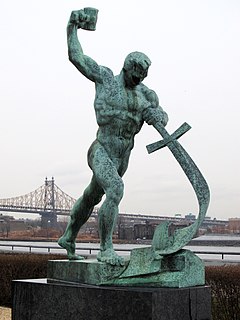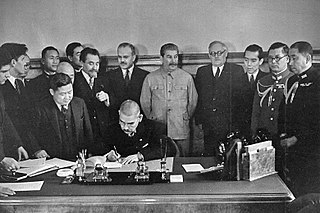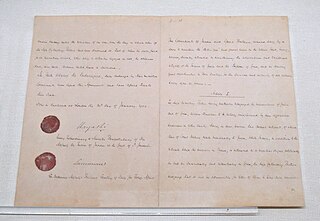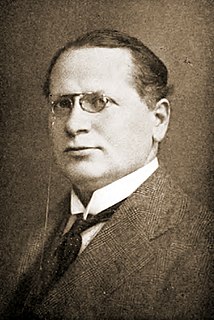
The Kellogg–Briand Pact is a 1928 international agreement in which signatory states promised not to use war to resolve "disputes or conflicts of whatever nature or of whatever origin they may be, which may arise among them". There were no mechanisms for enforcement. Parties failing to abide by this promise "should be denied of the benefits furnished by [the] treaty". It was signed by Germany, France, and the United States on 27 August 1928, and by most other states soon after. Sponsored by France and the U.S., the Pact renounced the use of war and calls for the peaceful settlement of disputes. Similar provisions were incorporated into the Charter of the United Nations and other treaties, and it became a stepping-stone to a more activist American policy. It is named after its authors, United States Secretary of State Frank B. Kellogg and French foreign minister Aristide Briand. The pact was concluded outside the League of Nations and remains in effect.

The diplomatic history of the United States oscillated among three positions: isolation from diplomatic entanglements of other nations ; alliances with European and other military partners; and unilateralism, or operating on its own sovereign policy decisions. The US always was large in terms of area, but its population was small, only 4 million in 1790. Population growth was rapid, reaching 7.2 million in 1810, 32 million in 1860, 76 million in 1900, 132 million in 1940, and 316 million in 2013. Economic growth in terms of overall GDP was even faster. However, the nation's military strength was quite limited in peacetime before 1940.

Disarmament is the act of reducing, limiting, or abolishing weapons. Disarmament generally refers to a country's military or specific type of weaponry. Disarmament is often taken to mean total elimination of weapons of mass destruction, such as nuclear arms. General and Complete Disarmament was defined by the United Nations General Assembly as the elimination of all WMD, coupled with the “balanced reduction of armed forces and conventional armaments, based on the principle of undiminished security of the parties with a view to promoting or enhancing stability at a lower military level, taking into account the need of all States to protect their security.”

The Treaty of Shimonoseki, also known as Treaty of Bakan in China, was a treaty signed at the Shunpanrō hotel, Shimonoseki, Japan on 17 April 1895, between the Empire of Japan and Qing China, ending the First Sino-Japanese War. The peace conference took place from 20 March to 17 April 1895. This treaty followed and superseded the Sino-Japanese Friendship and Trade Treaty of 1871.

The Treaty of San Francisco, also called the Treaty of Peace with Japan, re-established peaceful relations between Japan and the Allied Powers on behalf of the United Nations to officially end hostilities and to seek redress for actions up to and including World War II. It was officially signed by 49 nations on 8 September 1951, in San Francisco, California, U.S. at the War Memorial Opera House, with three member states refusing to sign: The Soviet Union, Poland and Czechoslovakia, all part of the Soviet Bloc, and a further two states refused to send representatives: India and Yugoslavia. Italy and China were not invited, the latter due to disagreements on whether the Republic of China or the People's Republic of China represented the Chinese people. Korea was also not invited due to a similar disagreement on whether South Korea or North Korea represented the Korean people.

The Paris Peace Conference was the formal meeting in 1919 and 1920 of the victorious Allies after the end of World War I to set the peace terms for the defeated Central Powers. Dominated by the leaders of Britain, France, the United States and Italy, it resulted in five controversial treaties that rearranged the map of Europe and imposed financial penalties. Germany and the other losing nations had no voice which gave rise to political resentments that lasted for decades.

The Battle of Shanghai was the first of the twenty-two major engagements fought between the National Revolutionary Army (NRA) of the Republic of China (ROC) and the Imperial Japanese Army (IJA) of the Empire of Japan at the beginning of the Second Sino-Japanese War. It was one of the largest and bloodiest battles of the entire war, later described as "Stalingrad on the Yangtze".

The Soviet–Japanese Neutrality Pact, also known as the Japanese–Soviet Non-aggression Pact, was a neutrality pact between the Soviet Union and Japan signed on April 13, 1941, two years after the conclusion of the Soviet-Japanese Border War. The agreement meant that for most of World War II, the two nations fought against each other's allies but not each other. In 1945, late in the war, the Soviets scrapped the pact and joined the war against Japan.

The first Anglo-Japanese Alliance was an alliance between Britain and Japan, signed in January 1902. The alliance was signed in London at Lansdowne House on 30 January 1902 by Lord Lansdowne, British foreign secretary, and Hayashi Tadasu, Japanese diplomat. A diplomatic milestone that saw an end to Britain's splendid isolation, the alliance was renewed and expanded in scope twice, in 1905 and 1911, before its demise in 1921 and termination in 1923. The main threat for both sides was from Russia. The threat of war with Britain prevented France from joining its ally Russia in the Russo-Japanese War of 1904. However, it angered the United States and some British dominions, which were hostile to Japan.
This article is concerned with the events that preceded World War II in Asia.
Interventionism is a policy of non-defensive (proactive) activity undertaken by a nation-state, or other geo-political jurisdiction of a lesser or greater nature, to manipulate an economy and/or society. The most common applications of the term are for economic interventionism, and foreign interventionism.

The Nine-Power Treaty (Japanese: Kyūkakoku Jōyaku or Nine-Power Agreement (traditional Chinese: 九國公約; simplified Chinese: 九国公约; pinyin: jiǔ guó gōngyuē was a 1922 treaty affirming the sovereignty and territorial integrity of China as per the Open Door Policy. That was after the suzerainty system fell apart after the Western invasions of the Opium Wars, which outlawed the Chinese "Closed Door Policy" into China of the former Imperial Qing dynasty.

The Litvinov Protocol is the common name of an international peace treaty concluded in Moscow on February 9, 1929. Named after the chief Soviet diplomat moving the negotiations forward, Maxim Litvinov, the treaty provided for immediate implementation of the Kellogg-Briand Pact by its signatories, thereby formally renouncing war as a part of national foreign policy.

The London and Paris Conferences were two related conferences held in London and Paris during September–October 1954 to determine the status of West Germany. The talks concluded with the signing of the Paris Agreements, which granted West Germany full sovereignty, ended the occupation, and allowed its admittance to NATO. Furthermore, both West Germany and Italy joined the Brussels Treaty on 23 October 1954. The Agreements went into force on 5 May 1955. The participating powers included France, the United Kingdom, Belgium, the Netherlands, Luxembourg, West Germany, Italy, Canada, the United States, and remaining NATO members.

A treaty battleship was a battleship built in the 1920s or 1930s under the terms of one of a number of international treaties governing warship construction. Many of these ships played an active role in the Second World War, but few survived long after it.
The Trautmann Mediation was an attempt by the German Ambassador to China, Oskar Trautmann, to broker a peace between Japanese Prime Minister Fumimaro Konoe and Chiang Kai-shek of the Chinese Kuomintang Government shortly after the Second Sino-Japanese War began. The mediation began in November 1937 and ended on January 16, 1938, with Konoe announcing its termination.
A peace congress, in international relations, has at times been defined in a way that would distinguish it from a peace conference, as an ambitious forum to carry out dispute resolution in international affairs, and prevent wars. This idea was widely promoted during the nineteenth century, anticipating the international bodies that would be set up in the twentieth century with comparable aims.
International relations (1919–1939) covers the main interactions shaping world history in this era, with emphasis on diplomacy and economic relations. The coverage here follows Diplomatic history of World War I and precedes Diplomatic history of World War II. The important stages of interwar diplomacy and international relations included resolutions of wartime issues, such as reparations owed by Germany and boundaries; American involvement in European finances and disarmament projects; the expectations and failures of the League of Nations; the relationships of the new countries to the old; the distrustful relations of the Soviet Union to the capitalist world; peace and disarmament efforts; responses to the Great Depression starting in 1929; the collapse of world trade; the collapse of democratic regimes one by one; the growth of economic autarky; Japanese aggressiveness toward China; Fascist diplomacy, including the aggressive moves by Mussolini's Italy and Hitler's Germany; the Spanish Civil War; the appeasement of Germany's expansionist moves toward the Rhineland, Austria, and Czechoslovakia, and the last, desperate stages of rearmament as another world war increasingly loomed.

History of Japanese foreign relations deals with the international relations in terms of diplomacy, economics and political affairs from about 1850 to 2000. The kingdom was virtually isolated before the 1850s, with limited contacts through Dutch traders. The Meiji Restoration was a political revolution that installed a new leadership that was eager to borrow Western technology and organization. The government in Tokyo carefully monitored and controlled outside interactions. Japanese delegations to Europe brought back European standards which were widely imposed across the government and the economy. Trade flourished, as Japan rapidly industrialized.

The history of U.S. foreign policy from 1913–1933 concerns the foreign policy of the United States during World War I and much of the Interwar period. The administrations of Presidents Woodrow Wilson, Warren G. Harding, Calvin Coolidge, and Herbert Hoover successively handled U.S. foreign policy during this period.















